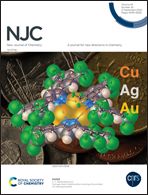Boosting the performance of D–A–D type hole-transporting materials for perovskite solar cells via tuning the acceptor group†
Abstract
In this work, two novel electron-deficient groups phenanthrothiadiazole (PT) and triphenylenobisthiadiazole (TBT) are utilized to construct donor–acceptor–donor (D–A–D) type hole-transporting materials (HTMs). The electronic, optical and charge transport properties are evaluated by performing quantum chemical calculations. Our results show that, in comparison with that of the benzothiadiazole (BT, SM-1) unit, the newly designed SM-2 and SM-3 display more deep highest occupied molecular orbital (HOMO) energy levels. Meanwhile, the blue-shifted light absorption spectra are also obtained, which will be helpful in enhancing the absorption of the perovskite layer. Unfortunately, the hole mobilities of SM-2 and SM-3 are slightly lower than that of SM-1 due to the weak intermolecular electronic coupling. In addition, we also find that better solubility and stable dimeric configuration are obtained for the new HTMs. Overall, this work provides some useful clues for designing new acceptor structures in D–A–D-type HTMs, and a potential HTM SM-3 is proposed.



 Please wait while we load your content...
Please wait while we load your content...